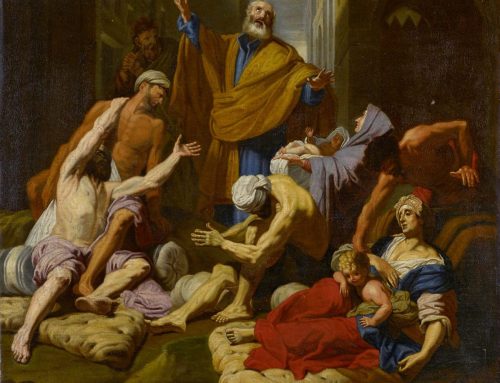
Today, June 16th, the Church celebrates Corpus Christi, Latin for “the Body of Christ.” Corpus Christi is also known as the Solemnity of the Most Holy Body and Blood of Christ and celebrates Christ’s Presence in the Eucharist. Why does the Catholic Church teach Christ is truly present in body, blood, soul, and divinity? The main reason is that Jesus told us so. St. John records the Savior’s words in chapter 6 of his Gospel, the Bread of Life Discourse, yet so many people don’t have faith in the Real Presence. Either Jesus is speaking literally in the Bread of Life Discourse or figuratively. Here are some interpretive keys for understanding the Bread of Life Discourse literally.
- Read the discourse in its immediate context. Consider how the people who heard Jesus firsthand interpreted what He said. Many of his followers were so scandalized by the concept of eating his flesh and drinking his blood that they left him, as John records in verses 60-66. They would have been unlikely to have had that reaction if they had believed he was speaking figuratively about eating his flesh and drinking his blood. As Jews, they knew that drinking blood was prohibited by the Mosaic law because “the life is in the blood” (Lev 17:14). (This takes on a new meaning when we understand that God doesn’t want us to have animal life in us, but divine life.) Did the followers of Christ misunderstand Him? Jesus doesn’t clarify in the following verses yet strengthens His words. Christ does, however, correct his disciples’ understanding in some contexts where He speaks figuratively. For example, in Matthew 16:5, Jesus, warning his disciples about the “yeast” of the Pharisees, is speaking figuratively, and He corrects their misunderstanding about the teaching in the verses following. If Jesus speaks figuratively in the Bread of Life Discourse and allows disciples to leave without His clarifying, what kind of person does that make Jesus? No, the disciples did not misunderstand Him. Jesus speaks literally and the saying is hard as John records-so they leave.
- Consider the cultural significance and language used. The language spoken in first century Judaism and the phrases and idioms in use at the time are important to understand in order to interpret Jesus’s words and intentions correctly. A figurative use of “eat my flesh”, already part of their language, meant to obliterate, conquer, or annihilate someone. A figurative understanding of Jesus’ words in the language spoken at that time would be incoherent. “Whoever annihilates me has eternal life” makes no sense.
- Review the original Greek words recorded by St. John meaning “eat”. The Greek term that John uses to convey Christ’s words about eating his flesh is trogein, which means to gnaw or chew on. It is doubtful that Christ would have used that specific word if he was speaking figuratively because the Greeks had several options of words meaning to eat which were less intense. “Gnaw on my flesh” is what John writes and this word usage doesn’t leave room for figurative analysis.
- Notice the relationship between “flesh and blood” to the word “spirit” in other parts of Sacred Scripture. The reader of the Bread of Life Discourse must distinguish the difference between “my flesh” and “the flesh” and understand them in relation to their usages in other passages of Scripture. Jesus ends His discourse with the words “the flesh is of no avail.” “My flesh” is not the same as “the flesh”, which has a special meaning in Scripture. As St. Paul records in I Cor 2:14, someone who is “unspiritual” refers who is living without the Holy Spirit. The flesh means unspiritual. Jesus says in John 6:63, “it is the spirit who gives life, the flesh is of no avail,” meaning one is not able to understand Christ’s teaching through reason alone. The teaching is revealed through the Holy Spirit, not through man’s natural reason. We can’t correctly understand the teaching on the Real Presence without the help of the Holy Spirit. According to the Catechism, “That in this sacrament are the true Body of Christ and his true Blood is something that ‘cannot be apprehended by the senses,’ says St. Thomas [Aquinas], ‘but only by faith, which relies on divine authority’ ”(CCC 1381). Therefore, we ought to be most grateful to the Holy Spirit for the infused theological virtue of faith if we have belief in the Real Presence in the Eucharist.
- Survey the writings of the Early Church. There are many writings from the early Church that leave little room for misinterpretation about their belief in the True Presence of Christ in the Eucharist. St. Ignatius of Antioch, a contemporary of St. John and writing in 110 AD, speaks of early heretics as he writes, “they abstain from prayer because they don’t confess in the flesh of our savior Jesus Christ” (Letter to the Smyrnaeans). St. Justin Martyr writing in 150 AD says, “We call this food Eucharist, and no one else is permitted to partake of it, except one who believes our teaching to be true… For not as common bread nor common drink do we receive but…the food, which has been made into the Eucharist by the Eucharistic prayer, is both the Flesh and the Blood of that incarnated Jesus” (First Apology). Even secular Romans writing in the 1st and 2nd centuries accused Christians of being cannibals, indicating that those proximate to Christians understood them to take Christ’s words literally.
The Catechism, quoting the Council of Trent, teaches, “Because Christ our Redeemer said that it was truly his body that he was offering under the species of bread, it has always been the conviction of the Church of God, and this holy Council now declares again, that by the consecration of the bread and wine there takes place a change of the whole substance of the bread into the substance of the body of Christ our Lord and of the whole substance of the wine into the substance of his blood” (CCC 1376).





Leave A Comment